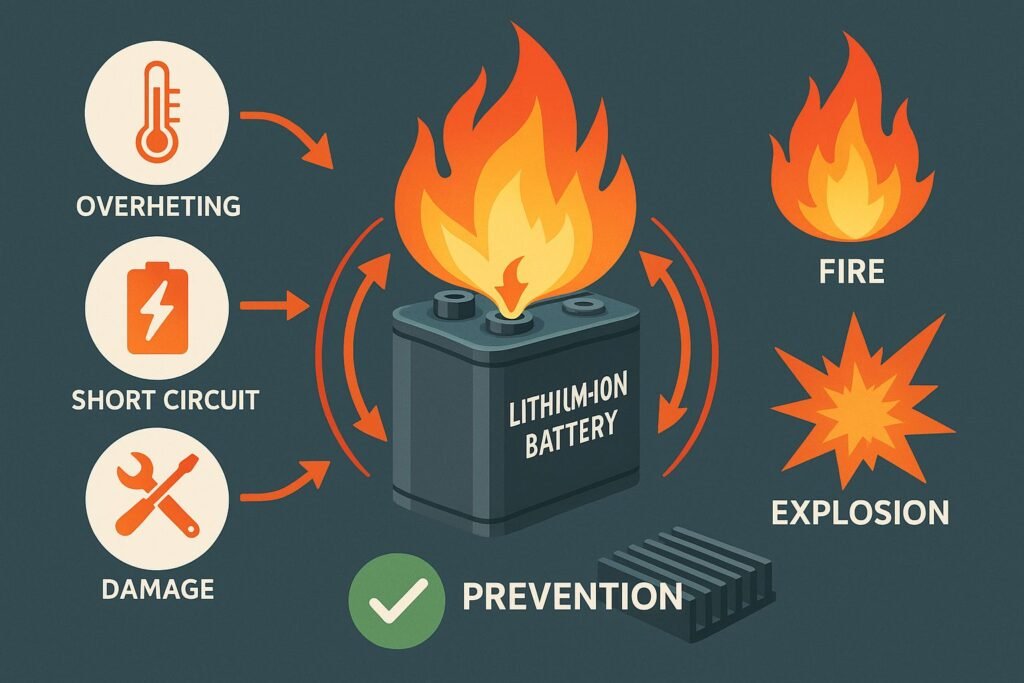
Table of Contents
Introduction
Lithium-ion batteries are the powerhouse behind today’s mobile revolution—powering everything from smartphones and laptops to electric vehicles and energy storage systems. But despite their many advantages—high energy density, long cycle life, and lightweight design—lithium-ion batteries carry a hidden risk: thermal runaway. This phenomenon has been at the root of many battery-related fires and explosions, making it a critical concern in battery design, manufacturing, and application.
In this blog, we’ll explore what thermal runaway is, what causes it, how it unfolds, and what measures can be taken to prevent it.
What is Thermal Runaway?
Thermal runaway is a self-sustaining, exothermic reaction that occurs within a battery cell, leading to rapid temperature rise and often catastrophic failure. It begins when the battery’s internal temperature reaches a critical threshold, triggering decomposition of cell materials and uncontrolled release of heat and gases. If not quickly mitigated, this process can result in fire, explosion, or both.
The Chain Reaction: How Thermal Runaway Occurs
- Initiation
Thermal runaway is usually triggered by internal or external stress factors such as:- Overcharging
- External heating
- Internal short circuits (caused by dendrite growth or manufacturing defects)
- Mechanical damage or puncturing
- Heat Generation
As the battery’s internal temperature increases, electrolyte decomposition begins. This is an exothermic reaction, releasing additional heat. - Accelerated Reaction
Higher temperatures accelerate the breakdown of the solid electrolyte interphase (SEI) and promote cathode decomposition, both of which release gases and more heat. - Pressure Build-up and Venting
Gases (e.g., CO₂, CO, and flammable hydrocarbons) increase internal pressure. If the cell casing cannot withstand it, venting, rupture, or explosion may occur. - Propagation to Nearby Cells
In battery packs, heat from one cell can quickly spread to adjacent cells—thermal propagation—leading to a chain reaction and large-scale failure.
Key Triggers and Contributing Factors
- Electrical Abuse: Overcharging or deep discharging can degrade the SEI layer or cause lithium plating, leading to internal shorts.
- Mechanical Abuse: Crush, penetration, or vibration can deform internal layers and puncture separators.
- Thermal Abuse: Exposure to high external temperatures (>60°C) can initiate reactions inside the cell.
- Poor Cell Design: Low-quality separators, poorly balanced electrodes, or non-uniform current distribution increase risk.
- Manufacturing Defects: Contaminants or misalignments can create microscopic faults that worsen with cycling.
Real-World Incidents
Several high-profile thermal runaway events have made headlines:
- Samsung Galaxy Note 7 (2016): Manufacturing flaws led to short circuits and battery fires, resulting in a global recall.
- Tesla Model S fires: Though rare, high-speed crashes causing battery pack damage have led to fire due to thermal runaway.
- Boeing 787 Dreamliner: In 2013, the aircraft’s lithium-ion battery system overheated, grounding the fleet until safety measures were improved.
Safety Mechanisms in Place
Modern lithium-ion batteries employ several strategies to reduce thermal runaway risk:
- Battery Management Systems (BMS): Continuously monitor voltage, current, and temperature to prevent overcharge/discharge.
- Thermal fuses and current interrupt devices (CID): Break the circuit if temperature or pressure gets too high.
- Vent holes and pressure relief valves: Allow controlled gas release before reaching explosive levels.
- High-quality separators: Shut down ion transport when temperature exceeds safe limits (shutdown separators).
- Thermal barriers between cells: Slow or stop thermal propagation in battery packs.
Preventive Measures and Best Practices
- Proper Charging: Always use manufacturer-approved chargers. Avoid charging at high temperatures or beyond specified voltage.
- Temperature Control: Keep batteries within safe operating range (typically 0°C to 45°C for charging).
- Regular Monitoring: Implement real-time health diagnostics in EVs and energy storage systems.
- Safe Design: Use cylindrical or prismatic cells with thermal barriers for better pack-level safety.
- End-of-Life Management: Retire and recycle degraded batteries before internal degradation becomes critical.
Future Outlook
Battery safety is a critical frontier in energy storage research. Emerging technologies like solid-state batteries, non-flammable electrolytes, and advanced thermal modeling promise to reduce the risk of thermal runaway. Simultaneously, advancements in AI-driven BMS and sensor integration are enhancing predictive maintenance and fault detection.
Conclusion
Thermal runaway is a dangerous but preventable failure mode in lithium-ion batteries. By understanding the root causes and implementing robust safety mechanisms, manufacturers, engineers, and consumers can minimize the risk and unlock the full potential of lithium-ion technology safely. As the world transitions to electric mobility and renewable energy, ensuring battery safety is not just a technical challenge—it’s a societal imperative.








